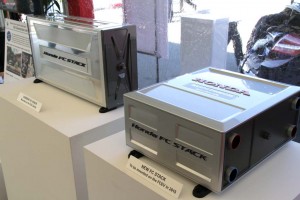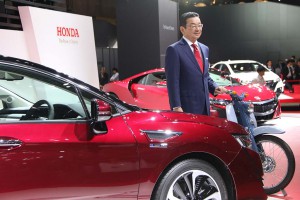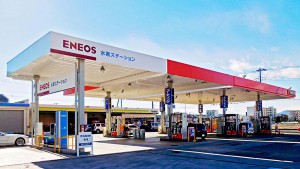Honda has officially rolled out its new Clarity fuel-cell-vehicle, with sales set to begin in Japan before expanding to the United States later this year.
The Japanese automaker becomes the third to come to market with a zero-emissions hydrogen car, though it expects sales numbers to be extremely small in the near-term.
Longer-term, Honda is hoping to improve the viability of fuel-cell technology, while also lowering costs as part of a proposed manufacturing partnership with General Motors, the Japanese maker’s CEO said Thursday, confirming a prior report on TheDetroitBureau.com. GM separately acknowledged discussions are underway.
(How does a fuel-cell vehicle work? Click Here for a primer on hydrogen power.)
By jointly building key components and sharing purchasing operations with GM, Honda CEO Takahiro Hachigo hopes to bring the cost of hydrogen cars down closer to what consumers are now paying for more conventional gas-electric vehicles, such as the Honda Accord Hybrid.
The new Honda Clarity Fuel-Cell Vehicle will be significantly more costly. It will debut in Japan at 7.66 million yen, or $67,000 at the current exchange rate. Most customers are expected to lease the vehicle for 100,000 yen, or $880 a month, though they will get some help from the Japanese government in the form of green vehicle subsidies.

Honda has sharply reduced the size of its latest fuel cell stack (r), compared to the older version (l) used in its original hydrogen car.
When it reaches the U.S., the Honda Clarity will go for $60,000, or $500 a month. But the vehicle also will qualify for both a $7,500 federal tax credit and additional subsidies from the State of California – the only place Honda plans to market the Clarity for now.
That’s in line with the pricing for both the new Toyota Mirai fuel-cell vehicle that just recently went on sale, as well as the Hyundai Tucson Fuel-Cell Vehicle that debuted in 2014.
Both of those models have generated only modest volume, in part due to pricing. Honda also forecasts low numbers initially. It anticipates selling just 200 Clarity fuel-cell vehicles in the first year, all of them to government groups, such as the country’s Environment Ministry.
Another factor holding back sales is the limited availability of hydrogen. In the U.S., there are only a handful of pumps open to the public, the vast majority of them in Southern California. As with Hyundai and Toyota, Honda will pre-qualify potential buyers to ensure they have easy access to one of those outlets.
Observers warn that hydrogen technology is caught in a chicken-and-egg syndrome. For one thing, energy providers won’t expand the fuel’s availability until there is higher demand, but demand won’t grow without more vehicles on the road.
Automakers like Honda hope that bringing down the cost of fuel-cell technology will help increase demand. Boosting economies of scale could help by jointly purchasing some components with a partner – in this case, General Motors – while also manufacturing key parts, such as the fuel-cell stack.
Honda and GM already participate in an advanced fuel-cell research program launched in 2013, something the Detroit maker said in a statement, “continues to make significant progress.”
As for taking the next step into manufacturing, “We are now advancing our discussions with Honda to encompass new areas of cooperation, including manufacturing and purchasing,” GM confirmed, though it said it currently has “nothing specific to announce” about the discussions.
(GM launches “global propulsion” unit to focus more on alternative power technologies. Click Here for the story.)
The heart of the technology, a stack combines hydrogen and oxygen in the presence of catalysts like platinum, producing a stream of current that can power electric motors, much like those used in a battery car. The only exhaust is water vapor.
Fuel-cell technology was invented in the 1850s but only saw serious application in the 1960s, providing electric power for the Apollo moon mission.
Today, almost every major automaker is working on fuel-cell technology, though it is unclear when – or if – others will bring hydrogen cars to market. In its statement, GM repeated it is “still working toward a plan for commercialization in the 2020 timeframe.”
(From Clarity to NSX, green cars to dominate Honda line-up. Click Here for more on that story.)


